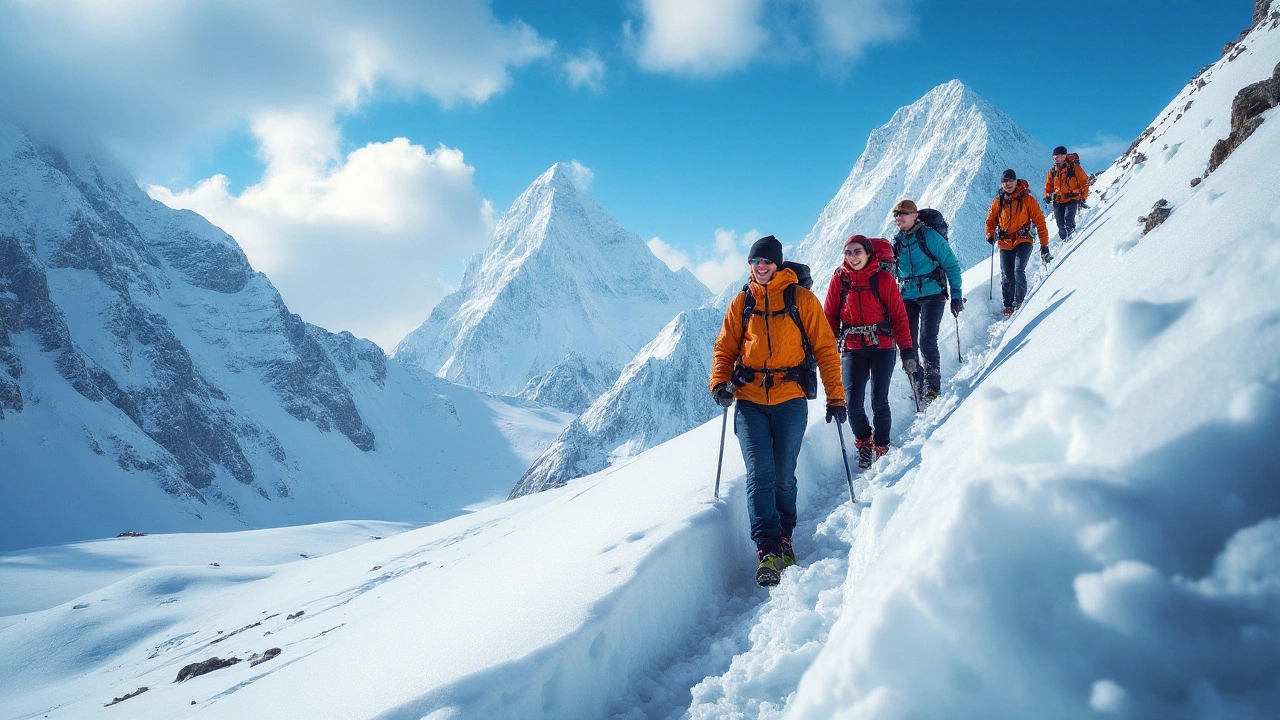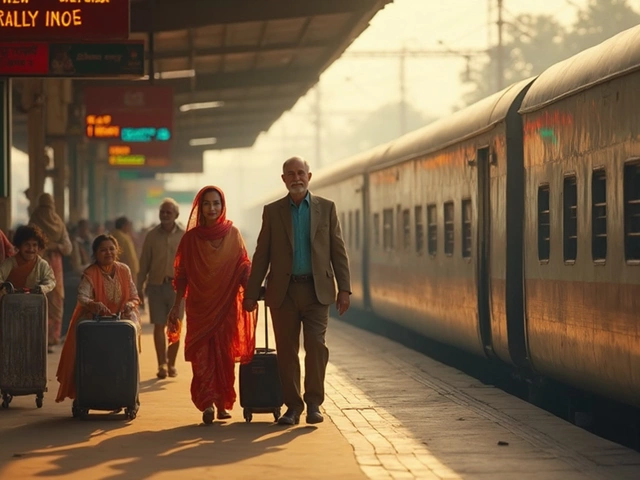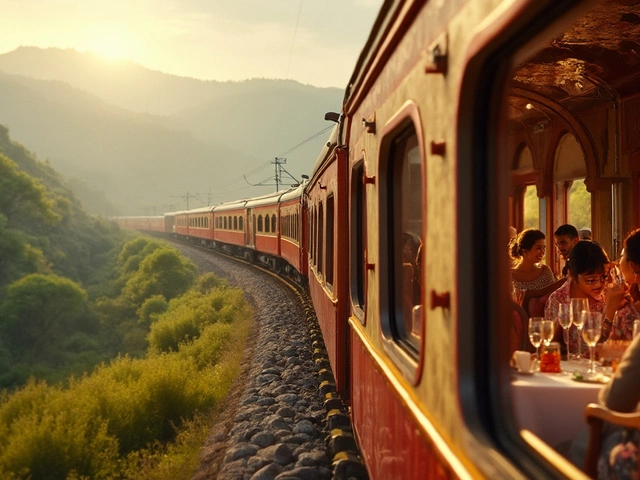For those with a love for the outdoors and a thirst for adventure, India's diverse terrains offer some of the most daunting and rewarding treks imaginable. While trekking is about challenging oneself, it also provides an opportunity to immerse in the captivating beauty of nature.
In the heart of India’s northern reaches, the Chadar Trek presents a unique challenge. Walking on a frozen river in the depths of winter is not for the faint-hearted but offers an experience like no other.
Further west, adventurers encounter the Roopkund Trek, known for its mysterious skeletal remains. The trek stretches through lush forests and steep climbs, offering panoramic views that tell stories of ancient travelers.
The Stok Kangri Trek brings the call of high altitudes, drawing mountaineers to summit peaks over 6,000 meters. A trek that challenges not only physical endurance but mental strength, it's one that leaves a profound impression.
Then there's the Goecha La Trek, a trail that embraces the shadows of the mighty Kangchenjunga, appealing to those who wish to journey close to the towering peaks with layers of history and culture enveloping each step.
- Chadar Trek: A Frozen Adventure
- Roopkund Trek: The Mystery Lake
- Stok Kangri Trek: A Daring Summit
- Goecha La Trek: Into the Heart of the Himalayas
Chadar Trek: A Frozen Adventure
The Chadar Trek is unlike any other trekking experience in India. Located in the remote Zanskar region of Ladakh, this trek is a journey over the frozen Zanskar River, which transforms into a solid sheet of ice during the harsh winters. This trek typically opens for adventurers during January and February, when the temperatures drop drastically, often plunging to as low as -30 degrees Celsius, testing the limits of endurance and preparation. The entire experience is akin to stepping into a winter wonderland, where the landscapes are painted in shades of white and silver, feeling untouched by time.
The beauty of Chadar Trek lies not just in the enchanting icy landscape but also in the cultural richness of the region. As trekkers move cautiously over the frozen river, they encounter ancient Buddhist monasteries perched on craggy hilltops and quaint villages whose inhabitants have adapted to one of the planet’s most inhospitable climates. It's these intertwining elements of ice and culture that render the Chadar Trek a coveted challenge among trekking enthusiasts.
One of the trek's most crucial aspects is preparation and safety. The unpredictably of ice makes it necessary for trekkers to use appropriate gear like ice picks, proper shoes, and layers of warm clothing. Accompanied by local guides, treks typically stretch over six to eight days, requiring a high level of fitness. This rigorous trek, though testing, bestows upon adventurers a unique sense of achievement. Adapting to this frozen environment involves understanding the fine balance between endurance, mentality, and nature's magnificence.
"Chadar Trek isn’t just about walking on a frozen river; it’s about the symphony of silence the ice sings to those willing to listen," says Nils Riber, an adventurous spirit and Himalayan trekker.
Weather conditions on the Chadar Trek can change without warning, and trekkers are always advised to be ready to face unforeseen challenges. It is not just about the icy terrain; the freezing winds add another layer to this extreme adventure. The temperature rigors require even sleeping systems to be specially designed to handle such conditions. Each night, sleeping below the open stars gives one a perspective on the stormy yet serene coexistence of nature.
Interestingly, this trek also offers a chance to understand the difficult lifestyle of the locals. Their resilience adds an aspect of human warmth to this cold journey, as they often share stories and hospitality with the travelers passing through. Chadar Trek not only pushes one to physical limits but also allows for introspective journeys intertwined with the breathtaking natural beauty that India proudly holds.
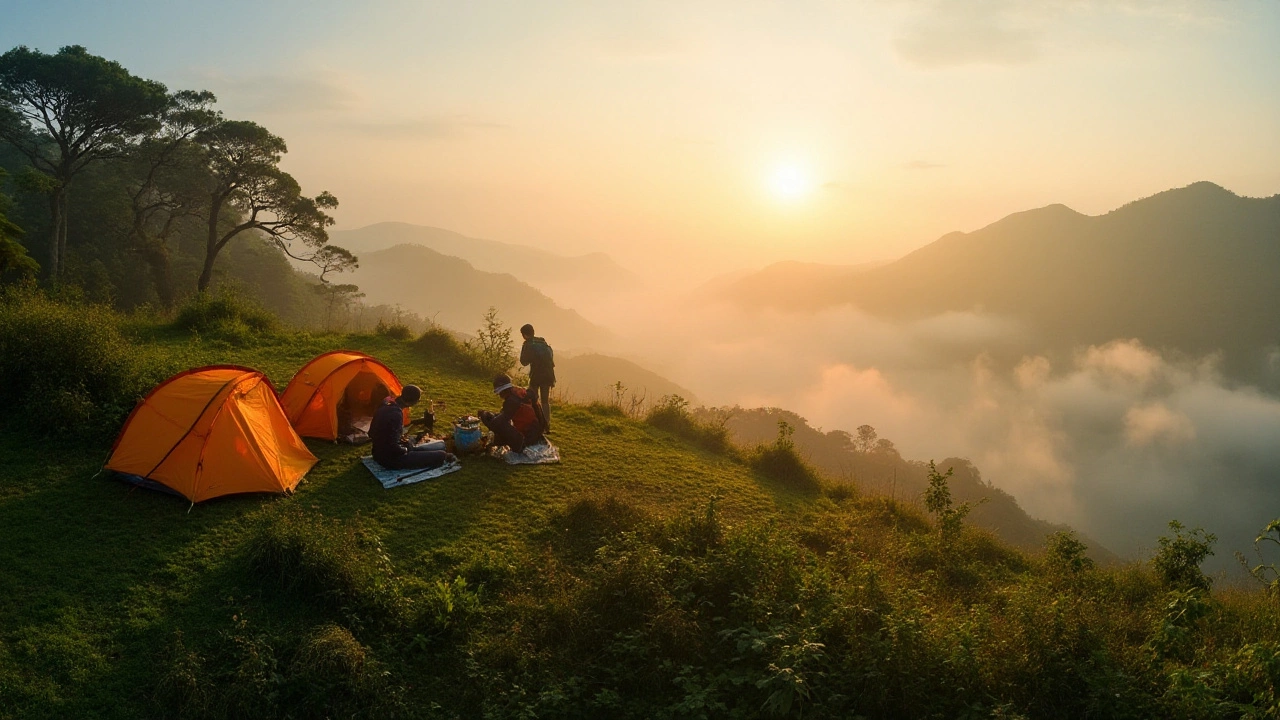
Roopkund Trek: The Mystery Lake
The Roopkund Trek, nestled in the Himalayas, is a journey that invites adventurers into a world of beauty and enigma. Standing at an altitude of approximately 5,029 meters, Roopkund Lake, also known as the Mystery Lake, captivates trekkers with its haunting allure. The lake, often frozen to a perfect stillness, famously reveals numerous human skeletal remains when the snow melts. These remains are believed to date back to the 9th century, presenting a puzzle that has intrigued scientists and historians alike. Theories abound, weaving tales of ancient pilgrims caught in disastrous hailstorms and forgotten traders meeting a tragic fate.
The trek to Roopkund offers a diverse tapestry of landscapes, from lush forests brimming with rhododendrons to steep rises blanketed by fields of snow. The journey begins in the quaint village of Lohajung, which serves as the gateway to awe-inspiring vistas and challenging paths. Trekkers often find themselves in the company of vibrant local culture and rich folklore, shared by the inhabitants of this rugged terrain. Each camp along the trail provides a unique perspective, with places like Ghora Lotani offering breathtaking views of the western Himalayas. The ascent becomes a testament to physical fortitude, but equally a pilgrimage of the spirit.
One of the defining features of the Roopkund Trek is its ability to challenge perceptions and endurance. Even experienced trekkers find themselves tested by unpredictable weather, steep climbs, and rugged terrain. But for those who venture past their comfort zone, the rewards are innumerable. The trail leads through meadows known as 'bugyals', where wildflowers dance against a backdrop of looming peaks, and into dense forests that echo with tales of the past. Reaching Roopkund Lake is more than an accomplishment; it is a momentous connection to the past, where the silence of the surroundings speaks volumes.
"The Roopkund Trek is not just a journey through landscapes, but a journey through time. It reminds us of the impermanence of life and the mysteries waiting in the uncharted." - Renowned mountaineer Harish Kapadia
For those plotting their own course to the Mystery Lake, preparation is key. The trek typically spans over seven to nine days, demanding a good level of physical fitness and altitude acclimatization. It is advised to pack in layers, with each layer serving against the varied climate encountered on the trek. Essential gear includes trekking poles, sturdy footwear, and waterproof clothing. Local guides, possessing invaluable knowledge of the region, often enhance the trekking experience, weaving cultural insights into the adventure.
The allure of Roopkund is captured not only in the journey itself but in the stories it continues to tell. Each trekker contributes to the living tapestry of this mysterious lake, adding their footsteps to centuries of untold narratives. Whether driven by the call of adventure or the pull of history, Roopkund remains a beacon for those seeking the ultimate trekking experience in India. The opportunity to stand at the edge of its enigmatic waters, contemplating the mysteries hidden beneath, is an experience that resonates long after the snow-covered trails wind back into the valleys.
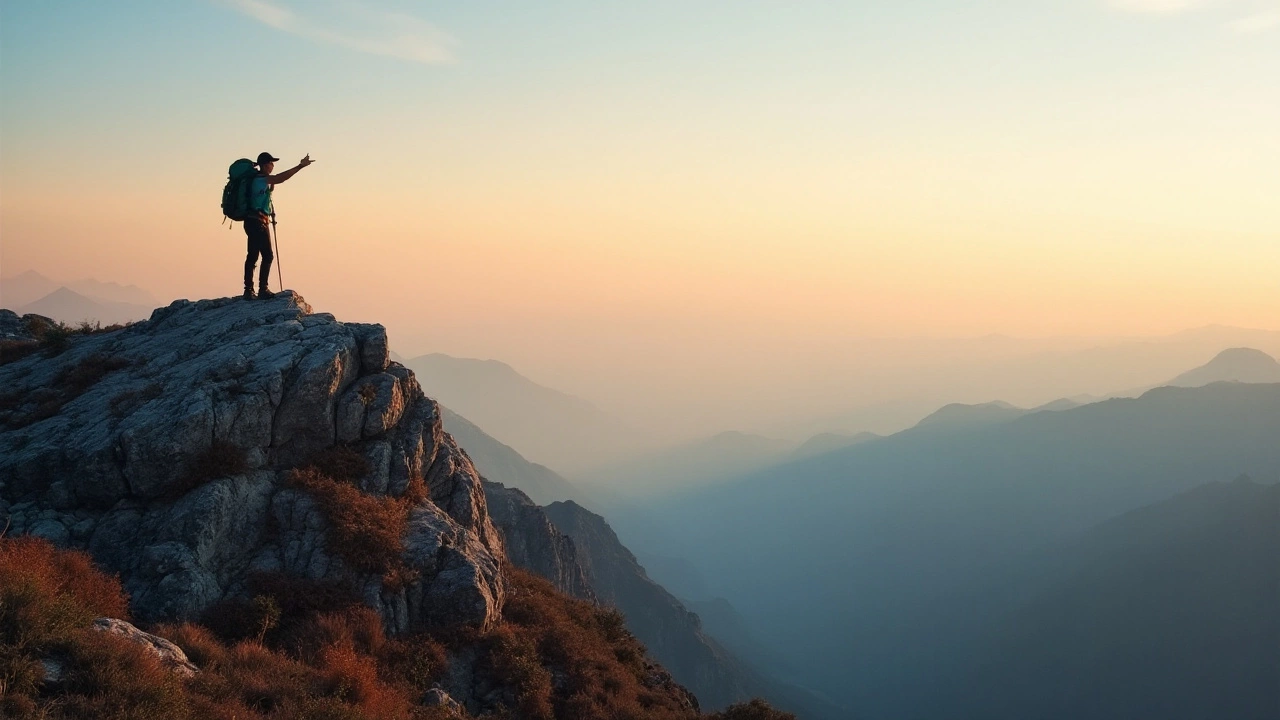
Stok Kangri Trek: A Daring Summit
The Stok Kangri Trek emerges as a lure for trekkers seeking the ultimate thrill amidst the vastness of India's great Himalayas. Standing tall at over 6,100 meters, Stok Kangri is not just another trekking peak; it is a testament to human endurance and spirit. Located in the stunning region of Ladakh, this trek challenges adventurers with its rigorous path that demands both physical and mental fortitude. The journey to the summit involves traversing through diverse landscapes, from desolate valleys to snow-clad peaks, each step revealing a new canvas painted by nature's hand.
Trekkers embarking on this bold expedition start their journey from the vibrant culture of Leh, acclimatizing to prepare for the high altitudes ahead. The trek progresses through the picturesque Stok village, which offers a glimpse into the local lifestyle and traditions. As you ascend, you find yourself surrounded by a surreal landscape that seems like something out of a dream—colossal mountains, crystal clear skies, and a silence that speaks volumes. Despite the challenges, experienced guides ensure a safe passage, sharing invaluable tips and insights along the way.
A key attraction of the Stok Kangri Trek is the summit ascent, which typically begins before dawn. Trekkers brace themselves for a heart-pounding climb as they make their way, equipped with crampons, navigating the icy corridors of the Himalayas under the guidance of starlight. The exertion pays off manifolds as the horizon unveils itself at dawn, treating those at the top with unrivaled vistas of Zanskar and the Indus Valley. It's these panoramic views and the powerful emotions at the peak that make every arduous step worthwhile.
Considered one of the more accessible yet physically testing summits of the Himalayas, the journey to Stok Kangri challenges one's limits but also highlights the importance of preparation. A trek of such magnitude requires robust acclimatization planning and a resilience built through physical conditioning. While it is achievable by fit beginners, assessing one's readiness is crucial. As part of pre-trek preparation, engaging in cardiovascular exercises and strength training is advised, not forgetting to focus on mental preparation for confronting unpredictable weather patterns and high altitude effects.
The trek has gained substantial popularity over recent years, and with that comes responsibility. The best time to embark on the Stok Kangri Trek is from mid-June to September, providing favorable weather conditions and breathtaking sights. However, with an increase in footfall, ethical trekking practices are encouraged to preserve the pristine beauty of the region, ensuring that nature's wonder can continue to captivate generations to come. As Edmund Hillary once remarked, "
It is not the mountain we conquer, but ourselves." and in the case of Stok Kangri, this sentiment holds especially true, with each ascent embedding lasting memories and transformative experiences within the soul of those who dare reach its summit.
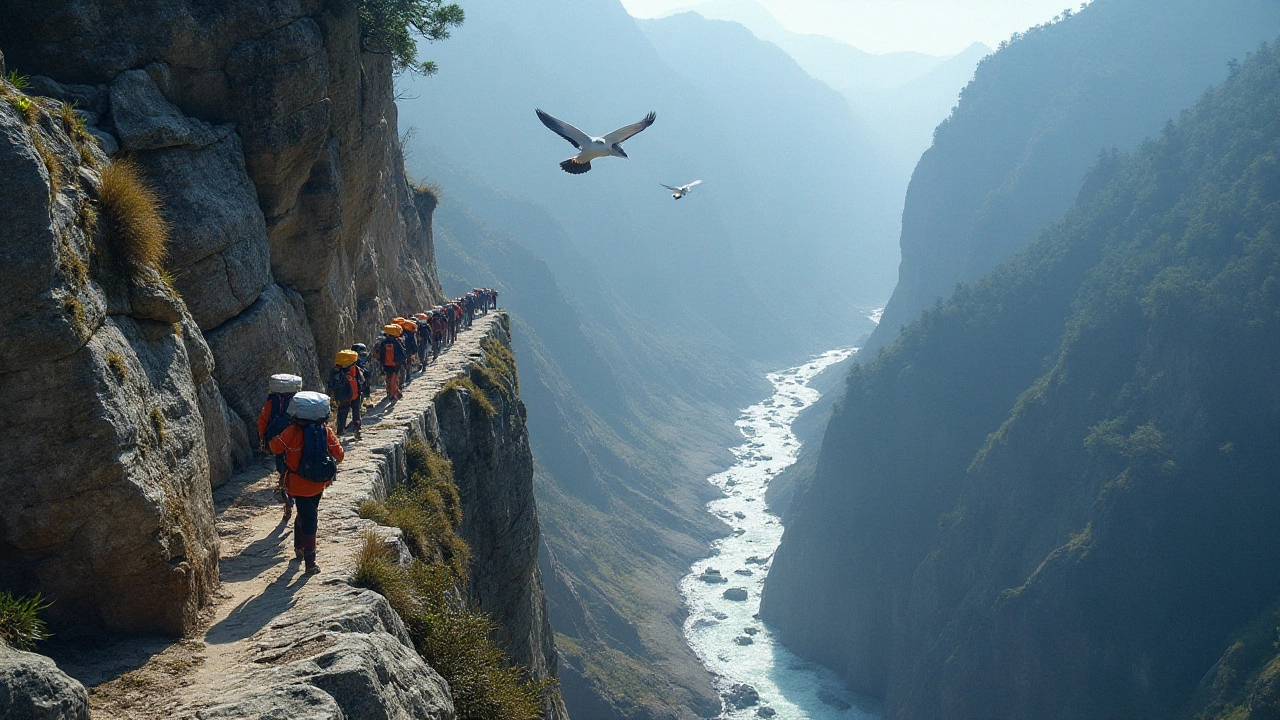
Goecha La Trek: Into the Heart of the Himalayas
Taking on the Goecha La Trek is like stepping into a realm where nature unveils its most majestic secrets. Situated in the heart of the Indian state of Sikkim, this trek offers an expedition deep into the Himalayas, with its trails weaving through spectacular landscapes that change dramatically as you ascend. The journey typically begins from the charming town of Yuksom, which serves as the gateway to the mesmerizing Kanchenjunga National Park. The trek is notable not only for its unparalleled views but also for the biodiversity that envelopes you with every step. Vast rhododendron forests, pristine alpine meadows, and crystal clear mountain lakes are just some of the wonders that make this trek so unique.
At the heart of the Goecha La Trek is the daunting yet mesmerizing view of the Kanchenjunga massif, the third tallest mountain in the world. As trekkers venture further into the route, they are usually treated to a sight so breathtaking that it oftentimes defies description. Many experienced trekkers say that it's the closest you've come to feeling at the edge of the world. The trek requires not just physical stamina, but mental resilience too, as the weather here can be unpredictable, offering gloriously sunny days one moment and grey, challenging conditions the next. Despite this, the trek remains a favorite among those who seek treks that combine challenge and beauty.
An experienced trekker once said, "When you stand at the summit of Goecha La, it's not just the view that takes your breath away - it's the realization that nature's majesty is boundless."
Beyond just a trek up the mountains, the Goecha La Trek embodies a journey into the cultural heart of Sikkim. The region is home to vibrant communities, each with its own rich traditions and histories that date back centuries. For those inclined to absorb cultural experiences, there are delightful interactions with local villagers along the way. This blend of culture and nature makes Goecha La more than just a climbing expedition - it's a cultural odyssey. The trek is usually completed in about 11 days, covering approximately 90 kilometers. Each day presents its own set of challenges, ranging from negotiating narrow paths carved along steep mountainsides to coping with high altitudes above 15,000 feet.
Trekking this path also highlights the importance of adhering to responsible trekking practices. Ensuring minimal environmental impact is something that many trekking groups emphasize. As the popularity of the Goecha La Trek grows, it's essential to protect the pristine conditions of these trails. Joining treks organized by responsible tour operators can ensure that future generations too can savor the sublime beauty of these landscapes. Ultimately, the trek is as much about conquering personal limits and embracing the cultural richness of Sikkim as it is about savoring nature's wonders.
